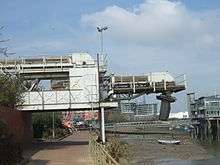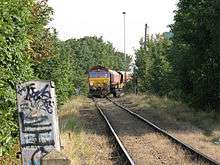Angerstein Wharf


Angerstein Wharf is the location of a marine construction aggregate and an associated cement facility, operated by the Cemex company, located on the south bank of the Bugsby's Reach of the River Thames in the New Charlton area of London in the Royal Borough of Greenwich. It has safeguarded wharf status.
Opening
The wharf was named after John Julius Angerstein (1732–1823), a local land owner, investor, businessman and art collector who built a 1 mile (1.6 km) long railway line from the line that runs from Blackheath to Charlton. When built the junction faced Blackheath but the junction now faces Charlton station. The branch was leased to the South Eastern Railway from 30 October 1852 to 1898 when they bought it outright. The company established its signal works at the location although according to an 1895 map the route towards Blackheath had been disconnected. This area is referred to as the Angerstein Triangle but the date of the signal works closing is unknown (believed to be early 1980s).
When opened the wharf had a river frontage of 755 feet (230 m) and could accommodate ships of up to 1,500 tons.[1]
Associated industries
Between 1820 and 1930 dredging contractors Flowers and Everett operated on the site and operated a narrow gauge system with three locomotives. The steel firm Redpath Dorman Long operated a steel fabrication plant on the site between 1903 and 1978. Another steel company - the Greenwich Metal Works - operated on the site between 1913 and 1976. Both companies operated privately owned shunting locomotives.[1]
Between 1919 and 1967 a large glass bottling factory operated by the United Glass Bottle Manufacturers was based on the site.[1]
Adjacent to the branch was the London County Council's central tram repair depot (opened 1909) which was served by a siding off the branch. Another mile and a half siding served the South Metropolitan Gasworks, whilst a privately run firm called Christies supplied railway sleepers and had an extensive internal rail network on their site. By 1925 some 30,000 tons of sleepers and significant numbers of telegraph poles were being produced from this site. There was also a general goods facility dealing with manure, steel, rails,fertilisers, coal, coke, stone,flour,sand,slates, timber and petrol.
In 1886 the South Metropolitan Gas Company opened the East Greenwich Works. Coal Gas production ceased in 1968 and the chemical by-products plant closed eight years later. This site is now (in 2014) occupied by the Millennium Dome. The site had its own fleet of standard gauge locomotives as well as a small narrow gauge railway.[2]
The 1969 Railway Control Diagram showed a line along the wharf served by wagon turntables as well as the following companies having sidings on the site:
- A-A Oil (Anglo-American?)
- Shell-Mex and B.P.
- C A Harveys
- Christies[3]
- Renwick Wilton's
- London Transport Executive
- South Eastern Gas Board Siding
There were two engine sheds shown on the diagram (for BP and A-A) suggesting these companies had their own shunting locomotives on the site. From the overbridge belonging to the Greenwich railway line, the line was equipped with an overhead electrical supply rather than the standard third rail supply. This was for safety reasons and locomotives of British Rail Class 71 were equipped to use this.[4]
Passenger Traffic
Passenger trains were limited to enthusiast specials and photographic evidence of one run on 29 March 1958 can be found in Fig 65 of 'Charing Cross to Dartford' by Vic Mitchell and Keith Smith. On 10 January 1987 'The Blue Circular' railtour traversed the line formed of a Class 202 DEMU.[5] The 'Orange Pippin' railtour of 30 August 2003 was worked by two class 66 locomotives.[6]
Later history
During the 1970s the Angerstein Wharf site was used as a railhead to receive large stone boulders from Caldon Low (Staffordshire) in connection with the building of the Thames Barrier.[7]
Between 1963 and 1987 the Thames Metal Company operated a scrap yard on the site and this site was then taken over by Day Aggregates in 1993 and is the location of the current facility.
Since 1990 the site has been used almost exclusively used for loading and unloading of sea-dredged aggregates; as of 2014, the operator was Aggregate Industries.[8]
See also
References
- 1 2 3 Marden, Dave (2012). London's Dock Railways Part 1. Southampton: Kestrel Books. p. 86. ISBN 978-1-905505-27-2.
- ↑ Marden, Dave (2012). London's Dock Railways Part 1. Southampton: Kestrel Books. p. 87. ISBN 978-1-905505-27-2.
- ↑ "Greenwich Industrial History: A major timber importer on the Charlton riverside". Greenwichindustrialhistory.blogspot.co.uk. 2011-11-29. Retrieved 2014-02-25.
- ↑ Charing Cross to Dartford - Vic Mitchell and Keith Smith (Middleton Press ISBN 0 906520 75 4)
- ↑ http://www.sixbellsjunction.co.uk/80s/870110bl.htm accessed 3 July 2012
- ↑ http://www.sixbellsjunction.co.uk/00s/030830hr.htm Accessed 03/07/12
- ↑ Modern Railways magazine May 2012 Interview With Keith Winder Page 92
- ↑ "Freight train derailment at Angerstein Junction 2 April 2014" (PDF). Rail Accident Investigation Branch. RAIB. Retrieved 13 August 2015.
External links
- Press release
- Press release
- Map sources for Angerstein Wharf
Coordinates: 51°29′36″N 0°01′16″E / 51.49342°N 0.02103°E